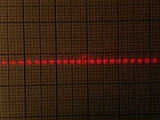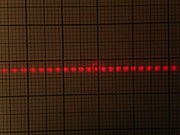
Extraordinary Optical Transmission
Encyclopedia

Light
Light or visible light is electromagnetic radiation that is visible to the human eye, and is responsible for the sense of sight. Visible light has wavelength in a range from about 380 nanometres to about 740 nm, with a frequency range of about 405 THz to 790 THz...
of a certain wavelength
Wavelength
In physics, the wavelength of a sinusoidal wave is the spatial period of the wave—the distance over which the wave's shape repeats.It is usually determined by considering the distance between consecutive corresponding points of the same phase, such as crests, troughs, or zero crossings, and is a...
falls on a subwavelength aperture, it is diffracted
Diffraction
Diffraction refers to various phenomena which occur when a wave encounters an obstacle. Italian scientist Francesco Maria Grimaldi coined the word "diffraction" and was the first to record accurate observations of the phenomenon in 1665...
isotropically
Isotropy
Isotropy is uniformity in all orientations; it is derived from the Greek iso and tropos . Precise definitions depend on the subject area. Exceptions, or inequalities, are frequently indicated by the prefix an, hence anisotropy. Anisotropy is also used to describe situations where properties vary...
in all directions evenly, with minimal far-field transmission. This is the understanding from classical aperture theory as described by Bethe. In EOT however, the regularly repeating structure enables much higher transmission efficiency to occur, up to several orders of magnitude greater than that predicted by classical aperture theory.
This phenomenon is attributed to the presence of surface plasmon
Surface plasmon
Surface plasmons , are coherent electron oscillations that exist at the interface between any two materials where the real part of the dielectric function changes sign across the interface...
resonances and constructive interference. A surface plasmon (SP) is a collective excitation of the electron
Electron
The electron is a subatomic particle with a negative elementary electric charge. It has no known components or substructure; in other words, it is generally thought to be an elementary particle. An electron has a mass that is approximately 1/1836 that of the proton...
s at the junction between a conductor
Electrical conductor
In physics and electrical engineering, a conductor is a material which contains movable electric charges. In metallic conductors such as copper or aluminum, the movable charged particles are electrons...
and an insulator
Electrical insulation
thumb|250px|[[Coaxial Cable]] with dielectric insulator supporting a central coreThis article refers to electrical insulation. For insulation of heat, see Thermal insulation...
and is one of a series of interactions between light and a metal surface called Plasmonics.
Currently, there is experimental evidence of EOT out of the optical range. Analytical approaches also predict EOT on perforated plates with a perfect conductor
Perfect conductor
A perfect conductor is an electrical conductor with no resistivity. The concept is used to model systems in which the electrical resistance or resistivity is negligible compared to other effects. One such model is ideal magnetohydrodynamics, the study of perfectly conductive fluids...
model. Holes can somewhat emulate plasmons at other regions of the Electromagnetic spectrum
Electromagnetic spectrum
The electromagnetic spectrum is the range of all possible frequencies of electromagnetic radiation. The "electromagnetic spectrum" of an object is the characteristic distribution of electromagnetic radiation emitted or absorbed by that particular object....
where they do not exist. Then, the plasmonic contribution is a very particular peculiarity of the EOT resonance and should not be taken as the main contribution to the phenomenon. More recent work has shown a strong contribution from overlapping evanescent wave coupling, which explains why surface plasmon resonance
Surface plasmon resonance
The excitation of surface plasmons by light is denoted as a surface plasmon resonance for planar surfaces or localized surface plasmon resonance for nanometer-sized metallic structures....
enhances the EOT effect on both sides of a metallic film at optical frequencies, but still accounts for the terahertz-range transmission.
Simple analytical explanations of this phenomenon have been elaborated, emphasizing the similarity between arrays of particles
and arrays of holes, and establishing that the phenomenon is dominated by diffraction
Diffraction
Diffraction refers to various phenomena which occur when a wave encounters an obstacle. Italian scientist Francesco Maria Grimaldi coined the word "diffraction" and was the first to record accurate observations of the phenomenon in 1665...
.
Applications
EOT is expected to play an important role in the creation of components of 'photonic' circuits. (Photonic circuits are analogous to electronic circuits.)One of the most ground-breaking results linked to EOT is the possibility to implement a Left-Handed Metamaterial
Metamaterial
Metamaterials are artificial materials engineered to have properties that may not be found in nature. Metamaterials usually gain their properties from structure rather than composition, using small inhomogeneities to create effective macroscopic behavior....
(LHM) by simply stacking hole arrays.
EOT-based chemical sensing is another major area of research. Much like in a traditional surface plasmon resonance
Surface plasmon resonance
The excitation of surface plasmons by light is denoted as a surface plasmon resonance for planar surfaces or localized surface plasmon resonance for nanometer-sized metallic structures....
sensor, the EOT efficiency varies with the wavelength of the incident light, and the value of the in-plane wavevector component. This can be exploited as a means of transducing chemical binding events by measuring a change in the local dielectric constant
Dielectric constant
The relative permittivity of a material under given conditions reflects the extent to which it concentrates electrostatic lines of flux. In technical terms, it is the ratio of the amount of electrical energy stored in a material by an applied voltage, relative to that stored in a vacuum...
(due to binding of the target species) as a shift in the spectral location of the EOT peak. EOT offers one key advantage over a Kretschmann-style SPR chemical sensor, that of being an inherently nanometer-micrometer scale device; it is therefore particularly amenable to miniaturization.

